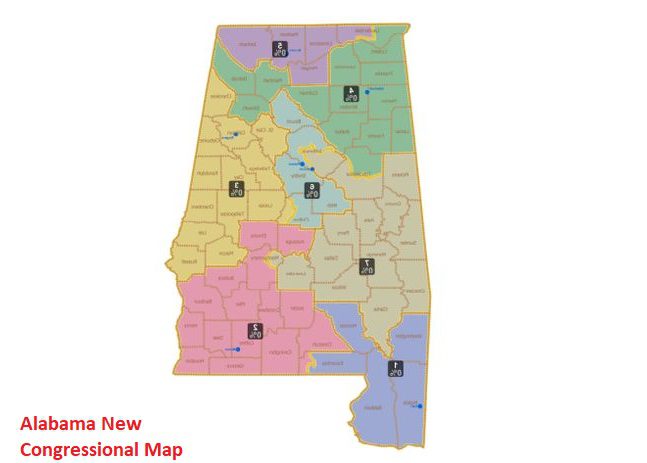Alabama New Congressional Map Raises Voting Rights Concerns
Alabama’s Republican-led Legislature recently passed a new congressional map, sparking outrage and legal challenges and setting the stage for another fierce battle over representation and voting rights. State Democrats and critics say the map rejects a recent U.S. Supreme Court decision by having only one majority-Black district and a second with less than 50% Black residents.
Republican state Sen. Steve Livingston’s map, quickly signed into law by Gov. Kay Ivey, has raised concerns that it may defy the Supreme Court’s June ruling. Conservatives say they acted responsibly, but critics say the map dilutes Black Alabamians’ voting power and undermines fair representation.
This legal battle centers on compliance with the Voting Rights Act (VRA). A federal court will evaluate the newly drawn districts’ VRA compliance. If in violation, a special master will redraw districts, complicating an already contentious situation.
Plaintiffs have until Friday to file objections before the court’s mid-August hearing, and they are expected to challenge the new map for failing to fix the Supreme Court’s Voting Rights Act violation. The court ordered “two districts in which Black voters either comprise a voting-age majority or something quite close to it.”
New map supporters say they’re “quite close” to meeting this requirement. Critics say the changes fail to adequately represent Black voters. The new map makes Black voters 39.93% of Alabama’s 2nd District, up from 30%, and 50.65% of the 7th District, down from 55%. The discrepancy is significant and has fueled partisan gerrymandering accusations.
GOP lawmakers in the state House and Senate rejected Democratic maps, including one with two majority-Black districts. This rejection increases Alabama redistricting controversy.
The plaintiffs’ lawyer, Deuel Ross, said they would fight what they saw as a deliberate attempt to deny Black voters representation. Critics say the Republican-led Legislature is ignoring the Voting Rights Act, the U.S. Supreme Court’s decision, and the three-judge district court’s order. They say this defiance insults constituents who want fair representation. The state’s political representation history is at stake. Only one of Alabama’s seven districts, represented by Democrat Terri Sewell, is majority-Black. White Republicans represent the remaining six districts, raising diversity and political participation concerns.
Critics also note that the Legislature’s new map appears to avoid conflicts between Republican incumbents, which could affect the 2024 U.S. House of Representatives. FiveThirtyEight found that Alabama’s new map may not allow Black voters to reliably elect their candidate, raising concerns about voter disenfranchisement.
Democratic Rep. Chris England called the new districts “a checklist of noncompliance” and accused Republicans of “finishing off the Voting Rights Act.” Democratic Minority Leader Bobby Singleton said conservatives wanted to “silence the voice of Black voters.”
Republicans say they know their state, people, and districts better than federal courts or activist groups. Governor Ivey praised the Legislature’s response to the court’s deadline, saying they remained focused on creating new districts.


State House Speaker Pro Tempore Chris Pringle, who co-chairs the redistricting committee, said the new districts were drawn to give minorities a chance to vote. Pringle said the districts were meant to be “compact and contiguous” and not “racial gerrymanders.”
The Alabama voting and representation fight intensifies as the legal battle heats up. This contentious debate will affect the state’s political landscape and voting rights and fair representation nationwide. Many still remember voting rights struggles, making equal representation a crucial part of American democracy.
Also Read: Spanish general Election: No Clear Winner
Our Reader’s Queries
How did Alabama’s congressional map change?
The addition of a new map includes a second congressional district, where the candidate favored by Black voters is expected to win most of the time. This is a victory for Black Alabamians and Democrats, who typically gain these votes. However, it is a setback for Republican leaders in Alabama, as they were twice criticized by the U.S. Supreme Court.
What is the new redistricting in Alabama?
Alabama’s legislature was mandated by the district court to revise the map and create two districts with a Black majority or near-majority. The goal is to address the dilution of Black Alabamans’ votes. The map must be redrawn prior to the 2022 congressional elections.
What are the two black districts in Alabama?
Alabama’s 2nd and 7th congressional districts, commonly referred to as the two Black seats, are up for grabs. Currently, the 2nd Congressional District is held by Rep. Barry Moore, a Republican who secured a 40 percentage point victory. However, indications suggest that Democrats are poised to claim this seat in the upcoming election.
How many congressional districts are in Alabama?
Alabama has been divided into seven congressional districts since the 1973 redistricting, which occurred after the 1970 U.S. census.

